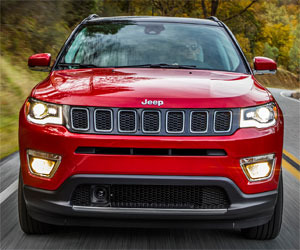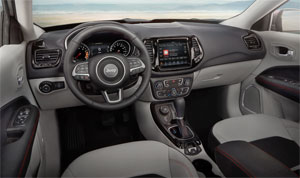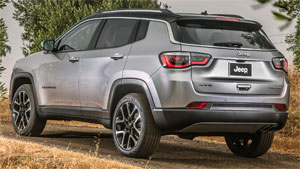2017 Jeep Compass
With the expanding Jeep lineup recently adding the subcompact Renegade, one might have thought the aged Compass’ was on its way out. Well not so fast, as Jeep has just released an all-new compact Compass, making for a two-pronged small SUV attack from the brand. Plus, this Compass claims to have shed its “near Jeep” reputation. So is the new Compass for “real”? Let’s all be the judge of that.
If you thought there wasn’t enough room in the Jeep lineup for another crossover between the Renegade and the Cherokee, well you’re wrong, as that spot is now filled by the reborn 2017 Jeep Compass.
And while that might not exactly cause mass cheering around your workplace or ours, it will certainly create some buzz in plenty of the over 100 countries that it will be sold in.
The Compass still rides on a front-wheel-drive based chassis, though no longer the Dodge Caliber’s; rather, the Fiat derived Jeep Renegade’s.
There’s a choice of two all-wheel-drive systems, Active Drive and Active Drive Low. Trailhawk editions come with Active Drive Low, which adds low range and Rock mode with Hill-Descent Control to the standard Selec-Terrain.
 The Compass’ exterior design is without a doubt much more SUVish in appearance than the compact wagon of before; drawing more cues from the larger Grand Cherokee than chassis-mate Renegade.
The Compass’ exterior design is without a doubt much more SUVish in appearance than the compact wagon of before; drawing more cues from the larger Grand Cherokee than chassis-mate Renegade.
The front end is still tall and chunky looking, with the shortened 7-slot grille stretching fully between the black-trimmed headlights. A black-painted roof is optional, as are LED tail lights.
And, for those Jeep Easter Eggs we’re not supposed to fully understand, there’s a lizard molded into the cowl, and a Loch Ness monster on the rear window.
We do understand FCA’s Tigershark 2.4-liter I4; our only engine choice for now. Here it produces 180-horsepower and 175 lb-ft. of torque. Walking up the trim levels will move you from 6-speed manual, to 6-speed automatic, and ultimately 9-speed auto.
The interior appears almost upscale, more so in Limited trim; with little Jeep quirkiness to be found. Front seat space is ample, made more so by a very low console for an almost airy feel.
Seat cushions felt firm initially; but after a long day in the saddle, they proved to be very comfortable.
Rear seat space is good on headroom, adequate on legroom, but the cushions are harder and flatter.
Even base models feature a UConnect touchscreen center dash, but upgrading to navigation gets you a much larger 8.5-inch version.
 A handy power lift gate is optional. Behind it is a good 27.2 cu-ft. of cargo space. Split, nearly flat folding rear seats expand that to a respectable 59.8 cu-ft.
A handy power lift gate is optional. Behind it is a good 27.2 cu-ft. of cargo space. Split, nearly flat folding rear seats expand that to a respectable 59.8 cu-ft.
As for driving; well, The Compass never really feels overpowered, merely adequate.
And that 9-speed still seems to be a powertrain weak link. It seldom felt like it was in the right gear at the right time, and was rather slow to make any changes.
We found the ride to be, somewhat surprisingly, very smooth, even with the Limited’s 18-inch wheels. Interior noise levels suffered a bit from wind noise around the windows. The kind that makes you keep checking to see if they’re all the way up.
Always wanting to prove their off-road merits, Jeep arranged for backwoods time in Northern California. We hit some real trails, not just specially created obstacles as many carmakers like to send you through. We’re not talkin’ hardcore stuff here, but this little Compass Trailhawk is clearly more capable than anything else in its class.
But, our advice is that unless you plan to do lots of off-roading, skip the Trailhawk and stick with still-capable lesser trims and save some money. Or, spend about the same and go for luxury with Limited trim.
 It will take adding a few option packages, but comprehensive safety systems are available; including Full-speed Collision Warning Plus with Advanced Brake Assist.
It will take adding a few option packages, but comprehensive safety systems are available; including Full-speed Collision Warning Plus with Advanced Brake Assist.
Regardless of drivetrain, Government Fuel Economy Ratings are all very close to the front-wheel-drive manual’s 23-City, 32-Highway, and 26-Combined. Our mileage loop was right on at 25.9 MPG.
The Energy Impact Score is 12.7-barrels of annual oil consumption with 5.6-tons of CO2 emitted.
Compass base pricing ranges from a Sport at $22,090 to Limited at $30,090. But be advised, there are some 2017 Compass carryovers from last generation on dealer’s lots. Trust us, the new one is the one you want.
With crossover and SUV sales showing no sign of slowing down, FCA’s Jeep brand could probably put just about anything out there and be successful with it. That’s not what they did with the genuinely all-new 2017 Jeep Compass. It’s miles better than its predecessor. And, with Jeep more and more a global brand, this small and capable family runabout is certain to have loads of appeal both home and abroad.
Specifications
- Engine: 2.4 liter
- Horsepower: 180
- Torque: 175 lb-ft.
- EPA: 23 mpg city / 32 mpg highway
- Energy Impact: 12.7 barrels of oil/yr
- CO2 Emissions: 5.6 tons/yr
2025 Volkswagen ID. Buzz
Volkswagen Brings Beetlemania Level Of Excitement To Minivan Segment
The duty of upholding Volkswagen’s heritage has most recently been delegated to small legacy car names like Golf and Jetta. But hold on! A much larger, totally modern take on VW’s classic microbus has just buzzed over the horizon— the all-electric ID. Buzz. It’s been at the top of our minds since we first saw the concept back in 2017. Well, it’s finally here, so let’s get our groove into drive!
This 2025 Volkswagen ID. Buzz has indeed created the most buzz around Volkswagen since the Beetle’s return to the U.S. in the late 1990s. We couldn’t drive it anywhere without drawing a crowd. No wonder, just about everyone has a VW Microbus story to tell, and seeing this reimagined version rolling down the street brings back all those memories.
VW really pulled it off as far as we’re concerned, as it looks great without appearing over the top. All the cues are here: Big VW logo front and center, lots of greenhouse including A-pillar windows and mini sliders for the second-row passengers, D-pillar air vents, and two-tone wheels. And while its appearance may be pure retro, its drivetrain is far from it, as the ID. Buzz is all-electric, and unlike the new Beetle, the Buzz does retain the original Microbus’ rear-drive architecture.
Powering those rear wheels is a 210-kW motor drawing juice from a 91-kWh battery for a range of 234 miles; 200-kW max charging will get you to 80% in about 26 minutes. Buyers can add another small 80-kW motor up front for 4motion all-wheel-drive and an increase of total output from 282 to 335 horsepower with a combined 512 lb-ft of torque. It uses the same battery, but range estimates drop just slightly to 231 miles. But while those numbers are modest, we also found them to be quite conservative, as we observed as many as 287 miles available in our all-wheel-drive tester’s gauge display and were on pace for 273 miles in our driving loop.
One throwback theme that may be a turnoff to some is that it’s quite a step up into the Buzz’s front seats, but there’s certainly a commanding view of the road once you climb in. Second row seating can be either a three-place bench or a pair of captain’s chairs, so there’s generous room for seven or six passengers. The captain’s chairs in our Pro S Plus offer good support and very easy access to the third row.
Lots of flexibility too with the option to simply fold the seats or remove them altogether.
With the sliding side doors and a wide opening rear hatch, there’s plenty of access for loading big sport utility amounts of cargo. Lots of flexibility too with the option to simply fold the seats or remove them altogether, and the ability to create a full-length flat floor with a rear cargo shelf that covers some handy removable storage bins. There’s 18.6 cubic-feet of space behind the third row, 75.5 behind the second, and a max of 145.5. That’s more than a Chevrolet Tahoe. For smaller items, there are lots of cubbies throughout the cabin, along with a standard Buzz Box that can be moved to multiple locations.
With a design that prioritizes retro form and modern function over aero efficiency, the 4motion equipped ID. Buzz earns a Fair efficiency rating, using 42-kWh of electricity per 100 miles, and we weren’t sure what to expect at our Mason Dixon test track.
What we found was great torque off the line and drama free launches to 60 in just 5.3 seconds. It was very stable at speed and power delivery stayed steady most of the way down the track until we reached about 90 mph, when it began to taper off just before we finished the quarter-mile in 14.0 seconds flat at 97 mph.
With 1,200-lbs. of battery weight nestled in its 127.5-inch wheelbase, the Buzz felt planted to the pavement through our handling course. There was quite a bit of body roll to deal with, but surprisingly little understeer. In panic braking runs, pedal response was inconsistent, feeling soft at times, pushing back hard at others; but through it all, results were quite good, stopping from 60 in an average of just 108 feet.
Three interior themes are available, this Dune is the brightest, featuring coastal inspired wood optic dash décor, “gray and clay” leatherette surfaces, and a high-mounted central 12.9-inch touchscreen. Pricing starts with a rear-wheel-drive Pro S at $61,545; this Pro S Plus begins at $65,045, add another $4,500 for 4motion, which brings a few extra features along with all-wheel drive.
Retro design with old-school VW charm, modern EV drivetrain, big SUV capacity merged with minivan flexibility; it all comes together in this 2025 Volkswagen ID. Buzz. It’s easily one of the coolest rides of the year and one that will likely keep Volkswagen dealers buzzing for years to come, and that’s something no other people and things mover can say.
Specifications
As Tested
- Motor Setup: Dual-Motor AWD
- Battery Size: 91-kWh
- Horsepower: 335
- Torque: 512 lb-ft
- EPA Range: 231 miles
- 0-60 mph: 5.3 seconds
- 1/4 Mile: 14.0 seconds at 97 mph
- Braking, 60-0: 108 feet
- MW Test Loop: ~ 273 miles













































